fuse CHEVROLET CAMARO SS 2010 Owners Manual
[x] Cancel search | Manufacturer: CHEVROLET, Model Year: 2010, Model line: CAMARO SS, Model: CHEVROLET CAMARO SS 2010Pages: 372, PDF Size: 1.91 MB
Page 5 of 372
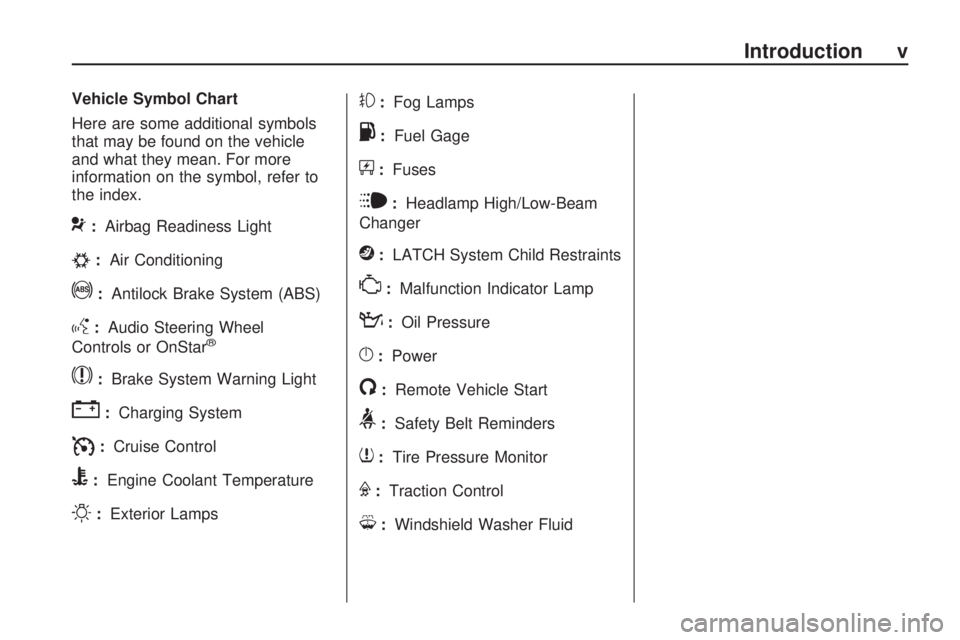
Vehicle Symbol Chart
Here are some additional symbols
that may be found on the vehicle
and what they mean. For more
information on the symbol, refer to
the index.
9:Airbag Readiness Light
#:Air Conditioning
!:Antilock Brake System (ABS)
g:Audio Steering Wheel
Controls or OnStar®
$:Brake System Warning Light
":Charging System
I:Cruise Control
B:Engine Coolant Temperature
O:Exterior Lamps
#:Fog Lamps
.:Fuel Gage
+:Fuses
i:Headlamp High/Low-Beam
Changer
j:LATCH System Child Restraints
*:Malfunction Indicator Lamp
::Oil Pressure
}:Power
/:Remote Vehicle Start
>:Safety Belt Reminders
7:Tire Pressure Monitor
F:Traction Control
M:Windshield Washer Fluid
Introduction v
Page 27 of 372
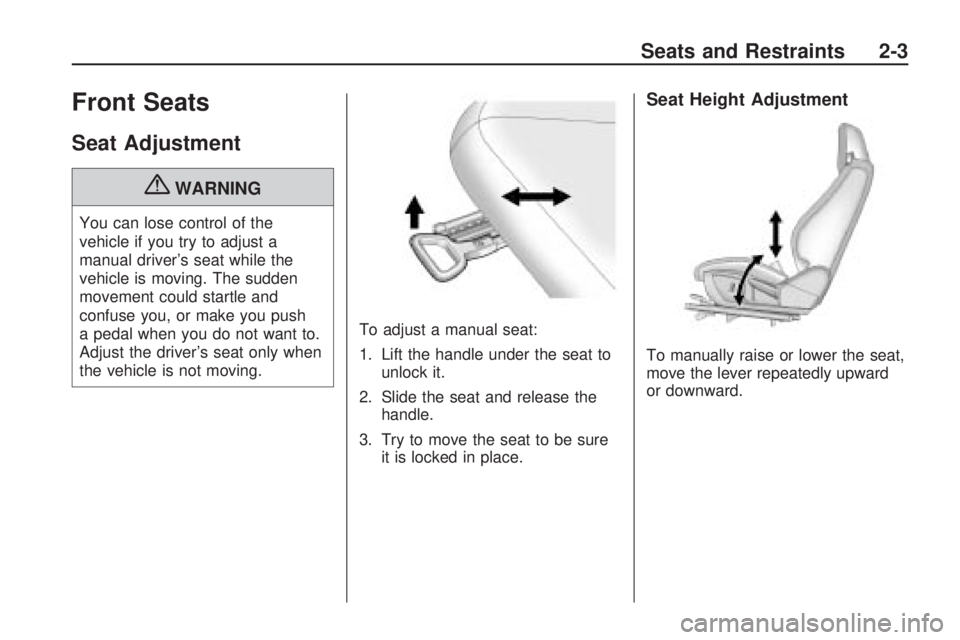
Front Seats
Seat Adjustment
{WARNING
You can lose control of the
vehicle if you try to adjust a
manual driver’s seat while the
vehicle is moving. The sudden
movement could startle and
confuse you, or make you push
a pedal when you do not want to.
Adjust the driver’s seat only when
the vehicle is not moving.To adjust a manual seat:
1. Lift the handle under the seat to
unlock it.
2. Slide the seat and release the
handle.
3. Try to move the seat to be sure
it is locked in place.
Seat Height Adjustment
To manually raise or lower the seat,
move the lever repeatedly upward
or downward.
Seats and Restraints 2-3
Page 28 of 372
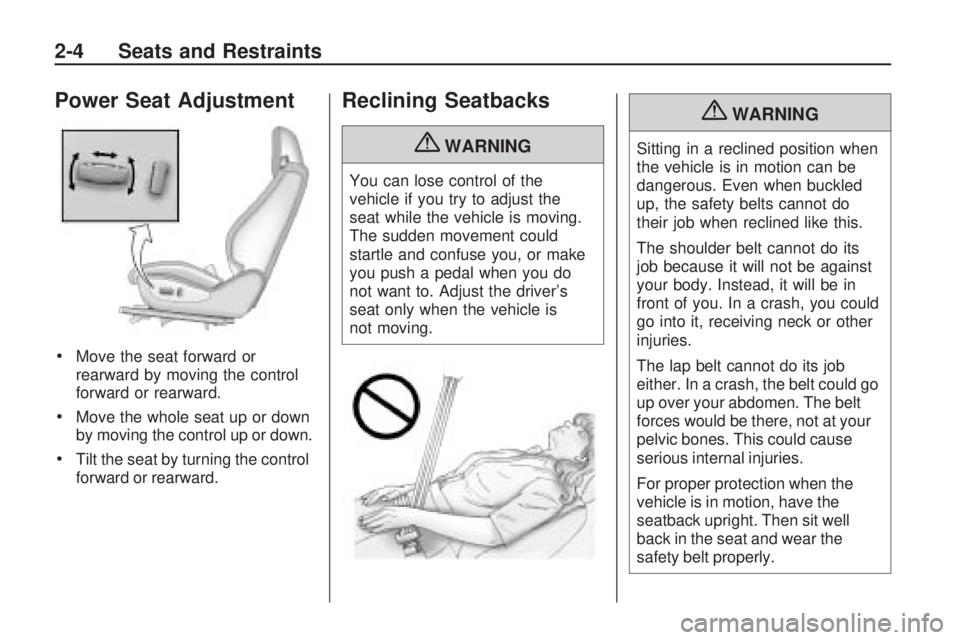
Power Seat Adjustment
•Move the seat forward or
rearward by moving the control
forward or rearward.
•Move the whole seat up or down
by moving the control up or down.
•Tilt the seat by turning the control
forward or rearward.
Reclining Seatbacks
{WARNING
You can lose control of the
vehicle if you try to adjust the
seat while the vehicle is moving.
The sudden movement could
startle and confuse you, or make
you push a pedal when you do
not want to. Adjust the driver’s
seat only when the vehicle is
not moving.
{WARNING
Sitting in a reclined position when
the vehicle is in motion can be
dangerous. Even when buckled
up, the safety belts cannot do
their job when reclined like this.
The shoulder belt cannot do its
job because it will not be against
your body. Instead, it will be in
front of you. In a crash, you could
go into it, receiving neck or other
injuries.
The lap belt cannot do its job
either. In a crash, the belt could go
up over your abdomen. The belt
forces would be there, not at your
pelvic bones. This could cause
serious internal injuries.
For proper protection when the
vehicle is in motion, have the
seatback upright. Then sit well
back in the seat and wear the
safety belt properly.
2-4 Seats and Restraints
Page 89 of 372
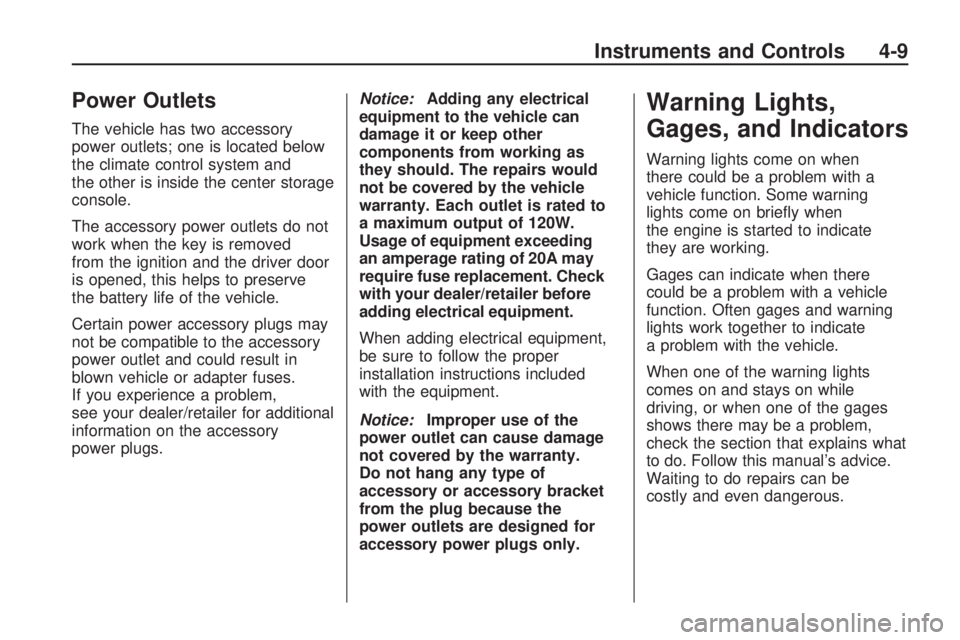
Power Outlets
The vehicle has two accessory
power outlets; one is located below
the climate control system and
the other is inside the center storage
console.
The accessory power outlets do not
work when the key is removed
from the ignition and the driver door
is opened, this helps to preserve
the battery life of the vehicle.
Certain power accessory plugs may
not be compatible to the accessory
power outlet and could result in
blown vehicle or adapter fuses.
If you experience a problem,
see your dealer/retailer for additional
information on the accessory
power plugs.Notice:Adding any electrical
equipment to the vehicle can
damage it or keep other
components from working as
they should. The repairs would
not be covered by the vehicle
warranty. Each outlet is rated to
a maximum output of 120W.
Usage of equipment exceeding
an amperage rating of 20A may
require fuse replacement. Check
with your dealer/retailer before
adding electrical equipment.
When adding electrical equipment,
be sure to follow the proper
installation instructions included
with the equipment.
Notice:Improper use of the
power outlet can cause damage
not covered by the warranty.
Do not hang any type of
accessory or accessory bracket
from the plug because the
power outlets are designed for
accessory power plugs only.
Warning Lights,
Gages, and Indicators
Warning lights come on when
there could be a problem with a
vehicle function. Some warning
lights come on briefly when
the engine is started to indicate
they are working.
Gages can indicate when there
could be a problem with a vehicle
function. Often gages and warning
lights work together to indicate
a problem with the vehicle.
When one of the warning lights
comes on and stays on while
driving, or when one of the gages
shows there may be a problem,
check the section that explains what
to do. Follow this manual’s advice.
Waiting to do repairs can be
costly and even dangerous.
Instruments and Controls 4-9
Page 135 of 372

The lever returns to its starting
position whenever it is released.
If after signaling a turn or lane
change the arrow flashes rapidly or
does not come on, a signal bulb
might be burned out.
Have the bulbs replaced. If the bulb
is not burned out, check the fuse.
SeeElectrical System Overload
on page 9-41.
Front Fog Lamps
For vehicles with front fog lamps,
the button is located on the exterior
lamp control, on the outboard
side of the steering wheel.
The ignition must be turned to
ON/RUN to turn on the fog lamps.
#:Press to turn the fog lamps
on or off. An indicator light on
the instrument panel cluster comes
on when the fog lamps are on.
The fog lamps come on together
with the parking and sidemarker
lamps.
If the high-beam headlamps are
turned on, the fog lamps will turn off.
If the high-beam headlamps are
turned off, the fog lamps will
turn back on again. For vehicles
with High Intensity Discharge (HID)
headlamps, the Daytime Running
Lamps (DRL) replace the fog lamps.
Some localities have laws that
require the headlamps to be
on along with the fog lamps.Interior Lighting
Instrument Panel
Illumination Control
This feature controls the brightness
of the instrument panel lights.
The thumbwheel is located next to
the exterior lamp control.
D(Instrument Panel Brightness):
Turn the thumbwheel up or down
to brighten or dim the instrument
panel lights.
Lighting 5-5
Page 197 of 372

To Use The Engine Coolant
Heater
1. Turn off the engine.
2. Open the hood and unwrap the
electrical cord.
The electrical cord is located
on the passenger side of the
engine compartment, in front
of the underhood fuse block
for V6 models.
3. Plug it into a normal, grounded
110-volt AC outlet.
{WARNING
Plugging the cord into an
ungrounded outlet could cause
an electrical shock. Also, the
wrong kind of extension cord
could overheat and cause a fire.
You could be seriously injured.
Plug the cord into a properly
grounded three-prong 110-volt AC
outlet. If the cord will not reach,
use a heavy-duty three-prong
extension cord rated for at least
15 amps.
4. Before starting the engine, be
sure to unplug and store the cord
as it was before to keep it away
from moving engine parts. If you
do not it could be damaged.
The length of time the heater
should remain plugged in depends
on several factors. Ask a dealer/
retailer in the area where you will
be parking the vehicle for the best
advice on this.
Shifting Into Park
{WARNING
It can be dangerous to get out of
the vehicle if the shift lever is not
fully in P (Park) with the parking
brake firmly set. The vehicle can
roll. If you have left the engine
running, the vehicle can move
suddenly. You or others could be
injured. To be sure the vehicle will
not move, even when you are on
fairly level ground, use the steps
that follow. If you are pulling a
trailer, seeDriving Characteristics
and Towing Tips on page 8-49.
Use this procedure to shift into
P (Park):
1. Hold the brake pedal down and
set the parking brake.
SeeParking Brake on page 8-32
for more information.
2. Hold the button on the shift lever
and push the lever toward the
front of the vehicle into P (Park).
Driving and Operating 8-21
Page 233 of 372

Vehicle Care
General InformationGeneral Information...............9-2
California Proposition 65
Warning.............................9-2
California Perchlorate
Materials Requirements........9-3
Accessories and
Modifications.......................9-3
Vehicle ChecksDoing Your Own
Service Work......................9-4
Hood...................................9-5
Engine Compartment
Overview............................9-6
Engine Cover.......................9-9
Engine Oil..........................9-10
Engine Oil Life System.........9-13
Automatic Transmission
Fluid................................9-14
Manual Transmission Fluid. . . .9-15
Hydraulic Clutch..................9-15
Engine Air Cleaner/Filter.......9-16
Cooling System...................9-17
Engine Coolant...................9-19
Engine Overheating.............9-24
Power Steering Fluid............9-25Washer Fluid......................9-26
Brakes...............................9-27
Brake Fluid.........................9-28
Battery...............................9-29
Rear Axle...........................9-30
Starter Switch Check............9-31
Automatic Transmission
Shift Lock Control
System Check...................9-32
Ignition Transmission
Lock Check.......................9-32
Park Brake and P (Park)
Mechanism Check..............9-32
Wiper Blade Replacement......9-33Headlamp AimingHeadlamp Aiming................9-34
Bulb ReplacementBulb Replacement...............9-37
Halogen Bulbs....................9-37
High Intensity Discharge
(HID) Lighting....................9-37
Headlamps, Front Turn
Signal and Parking Lamps
(Base Vehicle)...................9-37
Headlamps, Front Turn
Signal and Parking Lamps
(Up-Level Vehicle)..............9-38
Daytime Running
Lamps (DRL)....................9-39
Fog Lamps.........................9-40Taillamps, Turn Signal, and
Stoplamps.........................9-40
License Plate Lamp.............9-40
Replacement Bulbs..............9-41
Electrical SystemElectrical System
Overload...........................9-41
Fuses and Circuit
Breakers...........................9-42
Engine Compartment
Fuse Block.......................9-42
Instrument Panel
Fuse Block.......................9-45
Rear Compartment
Fuse Block.......................9-46
Wheels and TiresTires..................................9-48
Winter Tires........................9-48
Tire Sidewall Labeling..........9-49
Tire Designations.................9-51
Tire Terminology and
Definitions.........................9-52
Tire Pressure......................9-54
Tire Pressure for
High-Speed Operation........9-56
Tire Pressure Monitor
System.............................9-56
Tire Pressure Monitor
Operation..........................9-57
Tire Inspection....................9-61
Vehicle Care 9-1
Page 236 of 372

Vehicle Checks
Doing Your Own
Service Work
{WARNING
You can be injured and the
vehicle could be damaged if you
try to do service work on a vehicle
without knowing enough about it.
•Be sure you have sufficient
knowledge, experience, the
proper replacement parts, and
tools before attempting any
vehicle maintenance task.
(Continued)
WARNING (Continued)
•Be sure to use the proper
nuts, bolts, and other
fasteners. English and metric
fasteners can be easily
confused. If the wrong
fasteners are used, parts
can later break or fall off.
You could be hurt.
If doing some of your own service
work, use the proper service
manual. It tells you much more
about how to service the vehicle
than this manual can. To order
the proper service manual,
seeService Publications Ordering
Information on page 12-12.This vehicle has an airbag system.
Before attempting to do your
own service work, seeAirbag
System Check on page 2-34.
Keep a record with all parts receipts
and list the mileage and the date
of any service work performed.
SeeMaintenance Records on
page 10-10.
9-4 Vehicle Care
Page 239 of 372
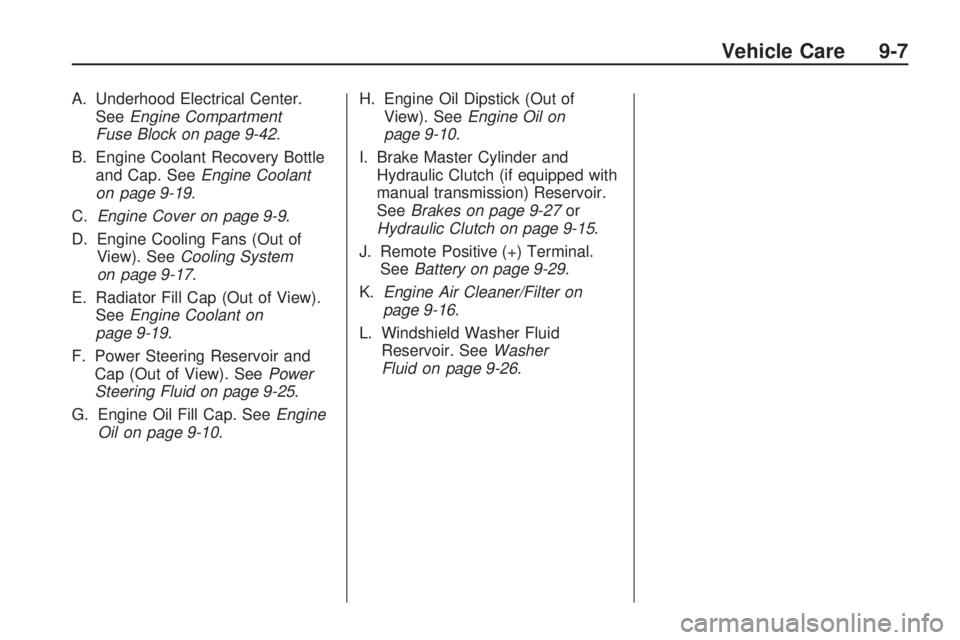
A. Underhood Electrical Center.
SeeEngine Compartment
Fuse Block on page 9-42.
B. Engine Coolant Recovery Bottle
and Cap. SeeEngine Coolant
on page 9-19.
C.Engine Cover on page 9-9.
D. Engine Cooling Fans (Out of
View). SeeCooling System
on page 9-17.
E. Radiator Fill Cap (Out of View).
SeeEngine Coolant on
page 9-19.
F. Power Steering Reservoir and
Cap (Out of View). SeePower
Steering Fluid on page 9-25.
G. Engine Oil Fill Cap. SeeEngine
Oil on page 9-10.H. Engine Oil Dipstick (Out of
View). SeeEngine Oil on
page 9-10.
I. Brake Master Cylinder and
Hydraulic Clutch (if equipped with
manual transmission) Reservoir.
SeeBrakes on page 9-27or
Hydraulic Clutch on page 9-15.
J. Remote Positive (+) Terminal.
SeeBattery on page 9-29.
K.Engine Air Cleaner/Filter on
page 9-16.
L. Windshield Washer Fluid
Reservoir. SeeWasher
Fluid on page 9-26.
Vehicle Care 9-7
Page 241 of 372
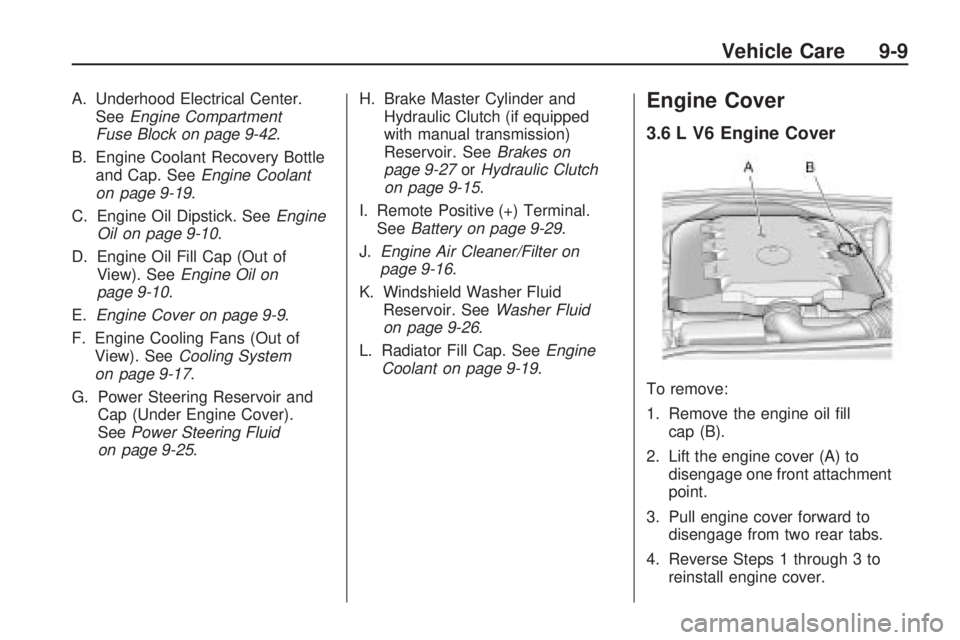
A. Underhood Electrical Center.
SeeEngine Compartment
Fuse Block on page 9-42.
B. Engine Coolant Recovery Bottle
and Cap. SeeEngine Coolant
on page 9-19.
C. Engine Oil Dipstick. SeeEngine
Oil on page 9-10.
D. Engine Oil Fill Cap (Out of
View). SeeEngine Oil on
page 9-10.
E.Engine Cover on page 9-9.
F. Engine Cooling Fans (Out of
View). SeeCooling System
on page 9-17.
G. Power Steering Reservoir and
Cap (Under Engine Cover).
SeePower Steering Fluid
on page 9-25.H. Brake Master Cylinder and
Hydraulic Clutch (if equipped
with manual transmission)
Reservoir. SeeBrakes on
page 9-27orHydraulic Clutch
on page 9-15.
I. Remote Positive (+) Terminal.
SeeBattery on page 9-29.
J.Engine Air Cleaner/Filter on
page 9-16.
K. Windshield Washer Fluid
Reservoir. SeeWasher Fluid
on page 9-26.
L. Radiator Fill Cap. SeeEngine
Coolant on page 9-19.Engine Cover
3.6 L V6 Engine Cover
To remove:
1. Remove the engine oil fill
cap (B).
2. Lift the engine cover (A) to
disengage one front attachment
point.
3. Pull engine cover forward to
disengage from two rear tabs.
4. Reverse Steps 1 through 3 to
reinstall engine cover.
Vehicle Care 9-9